Drink Reduction Over Time
The C Three Foundation conducted a random, anonymous survey of 100 people using the Sinclair 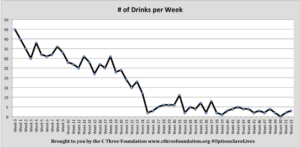 Method (TSM). People were invited to participate through email, social media, and the Options Save Lives forum.
Method (TSM). People were invited to participate through email, social media, and the Options Save Lives forum.
While we will unveil all of the results and insights on June 12, 2017 to celebrate four years of helping people achieve lasting recovery using the Sinclair Method, we wanted to spotlight one particular data set relating to how quickly TSM works.
TSM is a process. Also called pharmacological extinction, the process is similar to Pavlov’s dog, but in reverse–teaching an alcohol-dependent brain not to “salivate” or compulsively crave because of alcohol triggers (the bell). One of the difficult things to communicate without data is how long the process may take. After all, some people have more triggers, have struggled longer, or drink more than others. Some people have a family history of alcohol use disorder, or have co-occurring disorders, while others have simply developed a tolerance for alcohol and can go months between explosive binge drinking sessions.
It’s normal for those who are “rapid responders” to want to shout their success to the world. These people who have experienced something that feels miraculous have much to be thankful for as their lives are transformed and they return to the person they were before alcohol took over their life. Their stories are incredibly encouraging, but for those who take longer, there can be disappointment and doubt when success isn’t as dramatic.
If you are one of the majority of people who reduce your alcohol consumption more gradually, we hope the following information is both helpful and encouraging.
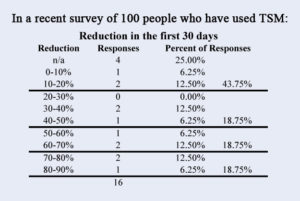 In the first 30 days, drink reduction can be slow as the learning process of targeted extinction is just beginning to develop. This is when a person begins to develop the habit of properly taking their medication. It’s also when a person beginning TSM may feel great amounts of anxiety as they wonder, “Will TSM work for me?” and “What will my family and friends think if they find out I’m doing this?”
In the first 30 days, drink reduction can be slow as the learning process of targeted extinction is just beginning to develop. This is when a person begins to develop the habit of properly taking their medication. It’s also when a person beginning TSM may feel great amounts of anxiety as they wonder, “Will TSM work for me?” and “What will my family and friends think if they find out I’m doing this?”
If you are struggling in the first 30 days, please join our peer support forum and download our free TSM drink log.
TIP #1: Medication side effects typically only last about 2 weeks. We have a tip sheet for minimizing side effects.
TIP #2: If you struggle with a daily habit of drinking, try to change your “normal” drinking time. Even 30 minutes can make a difference!
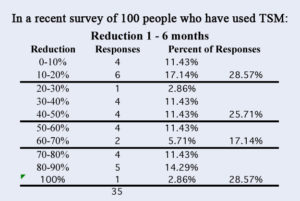 Between months 1 and 6, drink reduction gradually continues, but progress can still be slowed by drinking distilled liquor, drinking out of habit, or not adhering to medication requirements (i.e. forgetting to take medication or forgetting to wait the required time between medication and first drink).
Between months 1 and 6, drink reduction gradually continues, but progress can still be slowed by drinking distilled liquor, drinking out of habit, or not adhering to medication requirements (i.e. forgetting to take medication or forgetting to wait the required time between medication and first drink).
We often hear that those who struggle most during this period of time on TSM are either not taking their medication properly or their drink of choice is hard liquor. Vodka, whisky, rum, and other liquors have a higher alcohol by volume (ABV) and so it takes smaller amounts to equal a standard drink.
TIP #3: If you are struggling to see results in the first six months, and your drink of choice is liquor, try switching to beer or wine instead.
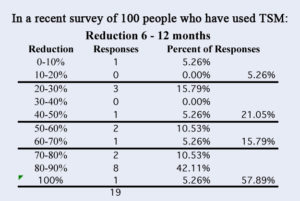 Between 6 and 12 months, more than half of those on TSM report a 70% or better reduction in drinking.
Between 6 and 12 months, more than half of those on TSM report a 70% or better reduction in drinking.
In the 6 to 12 month time frame, it is a good idea to review your goals. Are you using TSM to achieve abstinence? If not, what is your ultimate moderation goal? This is something only you can decide for yourself, but if you have health issues, please involve your doctor in the decision making process.
TIP #4: Many people get frustrated when they have not completely achieved their drink reduction goals in the first year. This is a great time to review your drink log to see how far you have progressed.
TIP #5: Make a list of the ways your life has improved while on TSM. Are your relationships with friends and family better? What do you enjoy again for the first time in years? Is there anything you’ve learned about yourself that makes you feel like a better person?
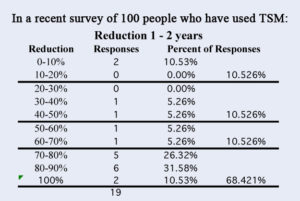 After 1 to 2 years on TSM, almost 70% of people report a drink reduction of 70% or more. This is a critical time for medication adherence and to protect against complacency. TSM is a lifetime commitment.
After 1 to 2 years on TSM, almost 70% of people report a drink reduction of 70% or more. This is a critical time for medication adherence and to protect against complacency. TSM is a lifetime commitment.
TIP #6: Even if you have reached your goal, never drink without your medication. It can be easier than you think for your brain to relearn alcohol cues and triggers.
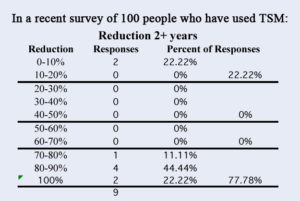 With continued medication adherence, nearly 80% of those on TSM have reduced drinking by 70% or more. Data includes self-reporting from 2-3 years (5), 3-4 years (2), 4-5 years (1), and 5+ years (1).
With continued medication adherence, nearly 80% of those on TSM have reduced drinking by 70% or more. Data includes self-reporting from 2-3 years (5), 3-4 years (2), 4-5 years (1), and 5+ years (1).
